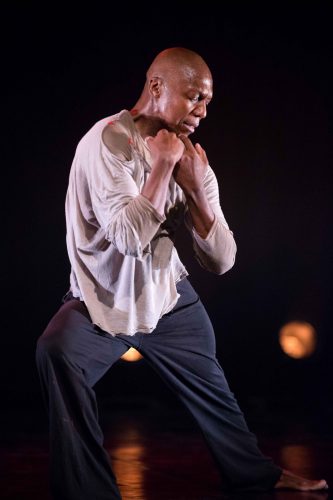
Growing up in Soweto township, choreographer and dancer Vincent Mantsoe found strength in the daily rhythm set by the women in his life.
“My grandmother, my mother, my auntie — I come from a family of sangoma, or traditional healers,” Mantsoe says. “They are the shamans. And their role in South Africa is to heal people — and part of that is dancing.”
Mantsoe brings his new work, KonKoriti, based on a song his grandmother used to sing him, to the University of Oregon this weekend.
“In my family, we practiced a ritual dance form every single day,” Mantsoe says. “At three o’clock in the morning, we beat the drum and accessed the spirit, before we can actually start our day.”
Soweto, like Indian reservations in this country, stands as a living reminder of a dehumanizing program of “native resettlement.”
The massive shantytown, spanning 41 square miles, features predominantly improvised housing, with many areas lacking adequate infrastructure such as sanitation, safe water and electricity.
Mantsoe was just 5 years old in 1976 when Soweto grabbed the world’s attention. Mass protests erupted over the government’s policy enforcing education in Afrikaans — a West Germanic language spoken by the colonial ruling party — rather than in the indigenous languages.
Ten thousand students marched — and police opened fire.
It was the beginning of a movement that would lead to change.
“I come up from a country under the apartheid regime, and as a young person I didn’t understand what was happening, but I had a feeling,” Mantsoe recalls. “When I was young, we saw people demonstrating, people dying, people arrested for no reason. I was young, but I knew what I saw. I saw the police — and their dogs.”
“And as a young man, growing up in this situation, you are filled with anger and you don’t know what to do,” he says. “So we formed a group called the Joy Dancers.”
A community outreach program, the Joy Dancers offered an alternative to membership in the township gangs known as tsotsi.
“In creating this group of young men, we were trying to find a way of expressing ourselves,” Mantsoe says.
These teenagers weren’t allowed into theaters, concert halls, libraries or cinemas — anywhere that whites might gather. But they could watch MTV.
Once per week, a local Johannesburg station broadcast American music videos “for the white kids,” Mantsoe says, and he and his friends never missed it — tuning into the neighborhood’s only television.
Enter Michael Jackson.
“For us, as young black African men, it’s, ‘Oh, it is possible! Look at this black man making it big in the USA!’” Mantsoe recalls.
“The O’Jays, the Temptations, Michael Jackson, Miles Davis — black musicians created a language for themselves,” Mantsoe says. “And we continued this voice — through dancing.”
The road wasn’t easy.
Though Mantsoe’s family used dance traditionally, they didn’t readily understand his choice to approach the form creatively. And in 1990, when Mantsoe and his peers ventured to Johannesburg to study contemporary dance, they discovered segregation — even in the studio.
Mantsoe’s solo work, KonKoriti, draws on these themes.
“KonKoriti is an ancient song that my grandmother used to sing,” Mantsoe says. “It’s about a man, or a woman for that matter. It’s about the pride and arrogance of this particular character.”
“My work is to create something that alludes to where I come from and what’s happening today,” Mantsoe says. “There are people who are doing that today — culturally or politically, that selfishness. In the USA today it’s the same story. But this is something that has happened since ages ago — since ancient times.”
Dance, Mantsoe says, offers a way forward.
“Dancing is about going somewhere.”
The UO Department of Dance presents Vincent Mantsoe at 8 pm Saturday, Oct. 28, in the Dougherty Dance Theatre, Gerlinger Annex, UO campus; FREE.